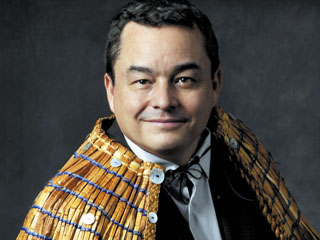By Gale Courey Toensing
Story Published: Jun 22, 2010

OTTAWA, Ontario – When Assembly of First Nations National Chief Shawn
A-in-chut-Atleo’s grandmother heard the Canadian government’s Apology
for Indian Residential Schools, she said, “It’s like they’re just
beginning to see us.”
National Chief Atleo, a hereditary chief from the Ahousaht First Nation,
recalled his late grandmother’s comment as he marked the second
anniversary of the apology with a teleconference June 11.
Canada’s Indian residential school system began in the mid-1840s –
almost 40 years earlier than the Indian residential schools in the
United States – and the last one closed in 1996.
Canadian Prime Minister Stephen Harper issued the formal apology June
11, 2008. Along with the apology, Canada’s federal government approved a
compensation agreement of at least $1.9 billion for an estimated 80,000
former residential school students.
“My thoughts today go to all of the survivors (of the residential
schools) on the second anniversary of the apology,” National Chief Atleo
said, noting that the first national Truth and Reconciliation Commission
event was scheduled to take place in Winnipeg June 16 – 19.
“I really think that we’re embarking on the work of reconciliation
between our peoples – between the Indian First Nations peoples and the
rest of the country, so there’s a lot of work ahead in that respect, and
I think included in that is a strong emphasis from all our First Nations
that the treaties remain central – the recognition of the need to uphold
the spirit and intent of the original treaties.”
The apology was offered as a result of an agreement forged between First
Nations and Canada, and “they upheld it, they forwarded it, and I think
the same goes with the treaties,” he said.
National Chief Atleo drew a parallel between treaties and the U.N.
Declaration on the Rights of Indigenous Peoples. The First Nations were
encouraged that in the Speech from the Throne earlier this year, the
federal government made a commitment to endorse UNDRIP, National Chief
Atleo said.
“I think first peoples see the Declaration as a minimum acceptable
international standard that mirrors the treaty relationship in many ways
so we want to see movement from the government to formerly endorse the
Declaration as a step on the journey of reconciliation,” he said.
The U.N. General Assembly adopted the declaration Sept. 13, 2007, with
143 countries voting in favor and four countries – Canada, the U.S.,
Australia and New Zealand – voting against it. Australia and New Zealand
have since endorsed the international human rights document.
Canada’s indigenous peoples are making a concerted effort to encourage
the Harper government to make good on its Throne Speech.
In May, the Assembly of First Nations, Inuit Tapiriit Kanatami and the
Metis National Council wrote to Harper, anticipating the state’s
endorsement of UNDRIP.
“The elaboration of the rights in the Declaration is a standard of
achievement to be pursued in a spirit of partnership and mutual
respect,” leaders of the three organizations wrote. “The Declaration
does indeed raise standards but it should not raise fears. We believe
our participation as the leadership of the three aboriginal peoples in
Canada in an announcement endorsing the Declaration is an expectation
that accords with the spirit of the Declaration, and would show
Canadians that the aboriginal peoples in Canada and the government of
Canada embrace the challenge of achieving the standards set out in the
Declaration.
On June 9, a coalition of 20 indigenous and civil society organizations
also wrote to Harper, urging adoption of the Declaration. Their letter
addressed concerns raised by the equivocal language of the Throne
Speech, which called UNDRIP an “aspirational document” and talked of
“qualified recognition” and endorsement “in a manner fully consistent
with Canada’s Constitution and laws.”
The organizations reminded Harper that Canada has never before placed
qualifications on its support for international human rights
instruments.
“A central objective of any international human rights instrument is to
encourage states to reform laws, policies and practices so that human
rights are respected. International human rights standards cannot merely
condone or sustain existing state practices. To limit U.N. declarations
in this way would defeat the purpose of having international standards.
To impose such limitation on the U.N. Declaration on the Rights of
Indigenous Peoples would constitute a discriminatory double standard,”
they wrote.
National Chief Atleo said the indigenous nations in Canada and the U.S.
increasingly are forging stronger ties to pursue issues of common
concern and interest, including economies and the environment.
Discussions are underway for a major energy and mining summit that would
bring together indigenous leaders from Canada, the U.S. and Mexico, and
indigenous leaders from the U.S. have been invited to AFM’s annual
meeting in Winnipeg in July, National Chief Atleo said.
“Certainly by working more closely together we can encourage both the
Canadian and American governments to recognize, respect and uphold their
obligations to honor the treaties and the nation-to-nation relationship.
And I think the Declaration is an excellent example of where we can draw
on our collective strength and not only reach out to the governments,
but to Canadian and American citizens to help them understand that they
as well are treaty people. They share a responsibility to uphold and
honor the treaties and they have a role to play.”
© 1998 - 2010 Indian Country Today. All Rights Reserved To subscribe or visit go to: http://www.indiancountry.com